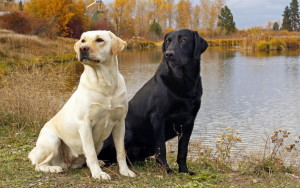The Labrador Retriever, also Labrador, is a type of retriever-gun dog. The Labrador is one of the most popular breeds of dog in the United Kingdom and the United States.
A favorite disability assistance breed in many countries, Labradors are frequently trained to aid the blind, those who have autism, to act as a therapy dog and perform screening and detection work for law enforcement and other official agencies. They are prized as sporting and hunting dogs.
Name
The foundational breed of what is now the Labrador Retriever was known as the St. John's water dog, St. John's dog, or Lesser Newfoundland. When the dogs were later brought to England, they were named after the geographic area known as "the Labrador" (they were known as Labrador Retrievers because they "retrieved" in the Labrador Sea) or simply Labrador to distinguish them from the larger Newfoundland breed, even though the breed was from the more southern Avalon Peninsula.
The progenitors of the Labrador retriever were actually from Newfoundland and Labrador exceptionally, the breed known as the Newfoundland was created near the same time in Labrador. The two breeds' names and origins were mixed once moved into England and the Americas. The dog from Labrador became the large, long furred dog we see and know today, and the dog from Newfoundland became the Labrador.
Yellow (and similar shades)
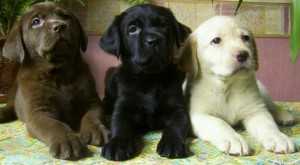
In the early years of the breed through to the mid-20th century, Labradors of a shade we would now call "yellow" were in fact a dark, almost butterscotch, color (visible in early yellow Labrador photographs). The shade was known as "Golden" until required to be changed by the UK Kennel Club, on the grounds that "Gold" was not actually a color. Over the 20th century a preference for far lighter shades of yellow through to cream prevailed, until today most yellow Labradors are of this shade. Also fawn has been a common color in the yellow lab variety.
Interest in the darker shades of gold and fox red were re-established by English breeders in the 1980s, and three dogs were instrumental in this change: Balrion King Frost (black, born c. 1976) who consistently sired "very dark yellow" offspring and is credited as having "the biggest influence in the re-development of the fox red shade", and his great-grandson, the likewise famous Wynfaul Tabasco (b. 1986), described as "the father of the modern fox red Labrador", and the only modern fox red Show Champion in the UK. Other dogs, such as Red Alert and Scrimshaw Placido Flamingo, are also credited with passing on the genes into more than one renowned bloodline.
Chocolate Labradors
Jack Vanderwyk traces the origins of all Chocolate Labradors listed on the LabradorNet database (some 34,000 Labrador dogs of all shades) to eight original bloodlines. However, the shade was not seen as a distinct color until the 20th century; before then according to Vanderwyk, such dogs can be traced but were not registered. A degree of crossbreeding with Flatcoat or Chesapeake Bay retrievers was also documented in the early 20th century, prior to recognition. Chocolate Labradors were also well established in the early 20th century at the kennels of the Earl of Feversham, and Lady Ward of Chiltonfoliat.
The bloodlines as traced by Vanderwyk each lead back to three black Labradors in the 1880s—Buccleuch Avon (m), and his sire and dam, Malmesbury Tramp (m), and Malmesbury June (f). Morningtown Tobla is also named as an important intermediary, and according to the studbook of Buccleuch Kennels, the chocolates in this kennel came through FTW Peter of Faskally (1908).
Description
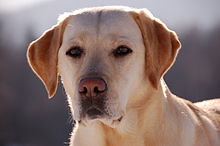
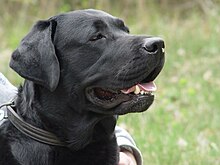
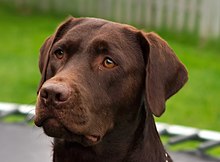
Appearance
Labradors are medium-large, with males typically weighing 65–80 lb (29–36 kg) and females 55–71 lb (25–32 kg). Labradors weighing close to or over 100 lb (45 kg) are considered obese or having a major fault under American Kennel Club standards, although some Labradors weigh significantly more. The majority of the characteristics of this breed, with the exception of colour, are the result of breeding to produce a working retriever.
As with some other breeds, the Conformation (typically "Show", "English" or "bench") and the Field (typically "Working" or "American") lines differ, although both lines are bred in both countries. In general, however, Conformation Labradors tend to be bred as medium-sized dogs, shorter and stockier with fuller faces and a slightly calmer nature than their Field counterparts, which are often bred as taller, lighter-framed dogs, with slightly less broad faces and a slightly longer nose. However, Field Labradors should still be proportional and fit within American Kennel Club standards. With Field Labradors, excessively long noses, thin heads, long legs, and lanky frames are not considered standard. These two types are informal and not codified or standardised; no distinction is made by the AKC or other kennel clubs, but the two types come from different breeding lines. Australian stock also exists; though not seen in the West, they are common in Asia. These dogs are also very good with children.
The breed tends to shed hair twice annually or regularly throughout the year in temperate climates. Some Labradors shed considerably; however, individual Labradors vary. Labrador hair is usually short and straight, and the tail is quite broad and strong. The webbed toes of the Labrador Retriever make them excellent swimmers. The webbing between their toes can also serve as a "snowshoe" in colder climates and keep snow from balling up between their toes—a condition that can be painful to other breeds with hair between the toes. Their interwoven coat is also relatively waterproof, providing more assistance for swimming.
Official breed standards
There is a great deal of variety among Labradors. The following characteristics are typical of the conformation show bred (bench-bred) lines of this breed in the United States and are based on the American Kennel Club standard. Significant differences between UK and US standards are noted.
- Size: Labradors are a medium-large breed. They should be as long from the withers to the base of the tail as they are from the floor to the withers. Males should stand 22–24 inches (56–61 cm) tall at the withers and weight 65–80 lb (29–36 kg). Females should stand 22–23 inches (56–58 cm) and weigh 55–71 lb (25–32 kg). By comparison under UK Kennel Club standards, height should be 22–24 inches (56–61 cm) for males, and 22–23 inches (56–58 cm) for females.
- Coat: The Labrador Retriever's coat should be short and dense, but not wiry. The coat is water-resistant, so the dog does not get cold when taking to water in the winter. That means that the dog naturally has a slightly dry, oily coat. Acceptable colours are black, yellow, and chocolate.
- Head: The head should be broad with slightly pronounced eyebrows. The eyes should be kind and expressive. Appropriate eye colours are brown and hazel. The lining around the eyes should be black. The ears should hang close to the head and set slightly above the eyes.
- Jaws: The jaws should be strong and powerful. The muzzle should be of medium length and should not be too tapered. The jaws should hang slightly and curve gracefully back.
- Body: The body should have a powerful and muscular build.
The tail and coat are designated "distinctive [or distinguishing] features" of the Labrador by both the Kennel Club and AKC. The AKC adds that "true Labrador Retriever temperament is as much a hallmark of the breed as the 'otter' tail."
Color

Labrador Retrievers are registered in three colors: black (a solid black colour), yellow (considered from cream to fox-red), and chocolate (medium to dark brown). Some dogs are sold as silver pure-bred Labradors, but purity of those bloodlines is currently disputed by breed experts including breed clubs and breed councils. Some major kennel clubs around the world allow silver Labradors to be registered, but not as silver. The Kennel Club (England) requires that they be registered as "Non-recognized.” Occasionally, Labradors will exhibit small amounts of white fur on their chest, paws, or tail, and rarely a purebred Lab will exhibit brindling stripes or tan points similar to a Rottweiler. These markings are a disqualification for show dogs but do not have any bearing on the dog's temperament or ability to be a good working or pet dog.
Puppies of all colours can potentially occur in the same litter. Color is determined primarily by three genes. The first gene (the B locus) determines the density of the coat's eumelanin pigment granules, if that pigment is allowed: dense granules result in a black coat, sparse ones give a chocolate coat. The second (E) locus determines whether the eumelanin is produced at all. A dog with the recessive e allele will produce only phaeomelanin pigment and will be yellow regardless of its genotype at the B locus. The genes known about previously have had their number increased by the introduction of the K locus, where the dominant "black" allele KB is now known to reside. Black or chocolate Labradors therefore must have the KB allele. Yellow Labradors are determined at the E locus, so the K locus is irrelevant in determining their colour. Variations in numerous other genes control the subtler details of the coat's colouration, which in yellow Labradors varies from white to light gold to a fox red. Chocolate and black Labradors' noses will match the coat colour.
According to a 2011 study, 13 out of 245 Labradors studied were heterozygous for the M264V mutation responsible for the melanistic mask, and one was homozygous. Within the breed, this trait is not visible.
Nose and skin pigmentation

are the nose, lips, gums, and the rims of the eyes.

Labrador coloration is controlled by multiple genes. It is possible for recessive genes to re-emerge in later generations. Also, there can sometimes be unexpected pigmentation effects to different parts of the body. Pigmentation effects appear in regard to yellow Labradors, and sometimes chocolate, and hence the majority of this section covers pigmentation within the yellow Labrador. The most common places where pigmentation is visible are the nose, lips, gums, feet, tail, and the rims of the eyes, which may be black, brown, light yellow-brown ("liver", caused by having two genes for chocolate), or several other colors. A Labrador can carry genes for a different colour, for example a black Labrador can carry recessive chocolate and yellow genes, and a yellow Labrador can carry recessive genes for the other two colours. DNA testing can reveal some aspects of these. Less common pigmentations (other than pink) are a fault, not a disqualification, and hence such dogs are still permitted to be shown.
The intensity of black pigment on yellow Labradors is controlled by a separate gene independent of the fur colouring. Yellow Labradors usually have black noses, which may gradually turn pink with age (called "snow nose" or "winter nose"). This is due to a reduction in the enzyme tyrosinase which indirectly controls the production of melanin, a dark colouring. Tyrosinase is temperature dependent—hence light coloration can be seasonal, due to cold weather—and is less produced with increasing age two years old onwards. As a result, the nose color of most yellow Labradors becomes a somewhat pink shade as they grow older.
A coloration known as "Dudley" is also possible. Dudleys are variously defined as yellow Labradors which have unpigmented (pink) noses (LRC), yellow with liver/chocolate pigmentation (AKC), or "flesh coloured" in addition to having the same colour around the rims of the eye, rather than having black or dark brown pigmentation. A yellow Labrador with brown or chocolate pigmentation, for example, a brown or chocolate nose, is not necessarily a Dudley, though according to the AKC's current standard it would be if it has chocolate rims around the eyes (or more accurately of the genotype eebb). Breed standards for Labradors considers a true Dudley to be a disqualifying feature in a conformation show Lab, such as one with a thoroughly pink nose or one lacking in any pigment along with flesh coloured rims around the eyes. True Dudleys are extremely rare. Breeding in order to correct pigmentation often lacks dependability. Because colour is determined by many genes, some of which are recessive, crossbreeding a pigmentation non-standard yellow Labrador to a black Labrador may not correct the matter or prevent future generations carrying the same recessive genes. For similar reasons, crossbreeding chocolate to yellow Labradors is also often avoided.
Show and field lines

Head and muzzle appearance: field (left), and show (right), showing the shorter muzzle length, more solid appearance head, and "pronounced" stop of the latter.

The field Labradors have lighter and slightly narrower heads with longer muzzles.
As a result of specialised breeding there are significant differences between field and trial-bred and show-bred lines of Labradors. In the United States the former are sometimes mistakenly referred to as "American" and the latter as "English" although both field and show types are bred in both countries. In the United Kingdom they are called "Field" and "Show". Dogs bred for hunting and field-trial work are selected first for working ability, where dogs bred to compete in conformation shows are selected for their conformation to the standards and characteristics sought by judges in the show ring.
While individual dogs may vary, in general show-bred Labradors are heavier built, slightly shorter-bodied, and have a thicker coat and tail. Field Labradors are generally longer legged, lighter, and more lithe in build, making them agile. In the head, show Labradors tend to have broader heads, better defined stops, and more powerful necks, while field Labradors have lighter and slightly narrower heads with longer muzzles. Field-bred Labradors are commonly higher energy and more high-strung compared to the Labrador bred for conformation showing while conformation breeds are calmer in energy, and as a consequence may be more suited to working relationships than being a "family pet". Some breeders, especially those specialising in the field type, feel that breed shows do not adequately recognise their type of dog, leading to occasional debate regarding officially splitting the breed into subtypes.
In the United States, the American Kennel Club(AKC) and the Labrador's breed club have set the breed standard to accommodate the field-bred Labrador somewhat. For instance, the AKC withers-height standards allow conformation dogs to be slightly taller than the equivalent British standard. However, dual champions, or dogs that excel in both the field and the show ring, are becoming more unusual.
Temperament
The AKC describes the Labrador's temperament as kind and pleasant.
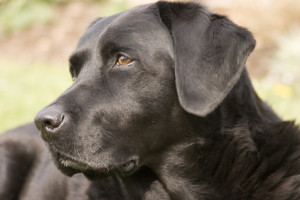
The AKC describes the Labrador's temperament as a kind, pleasant, outgoing and tractable nature. Labradors' sense of smell allows them to home in on almost any scent and follow the path of its origin. They generally stay on the scent until they find it. Navies, military forces and police forces use them as detection dogs to track down smugglers, thieves, terrorists and black marketers. Labradors instinctively enjoy holding objects and even hands or arms in their mouths, which they can do with great gentleness (a Labrador can carry an egg in its mouth without breaking it). They are known to have a very soft feel to the mouth, as a result of being bred to retrieve game such as waterfowl. They are prone to chewing objects (though they can be trained to abandon this behavior). The Labrador Retriever's coat repels water to some extent, thus facilitating the extensive use of the dog in waterfowl hunting. 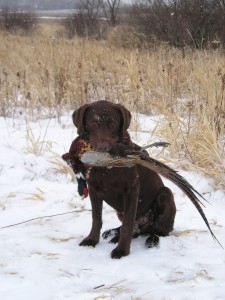
Labradors have a reputation as a very even-tempered breed and an excellent family dog. This includes a good reputation with children of all ages and other animals. Some lines, particularly those that have continued to be bred specifically for their skills at working in the field (rather than for their appearance), are particularly fast and athletic. Their fun-loving boisterousness and lack of fear may require training and firm handling at times to ensure it does not get out of hand—an uncontrolled adult can be quite problematic. Females may be slightly more independent than males. Labradors mature at around three years of age; before this time they can have a significant degree of puppy-like energy, often mislabelled as being hyperactive. Because of their enthusiasm, leash-training early on is suggested to prevent pulling when full-grown. Labradors often enjoy retrieving a ball endlessly (often obsessively) and other forms of activity (such as agility, frisbee, or flyball).
Although they will sometimes bark at noise, especially noise from an unseen source ("alarm barking"), Labradors are usually not noisy or territorial. They are often very easygoing and trusting with strangers and therefore are not usually suitable as guard dogs.
Labradors have a well-known reputation for appetite, and some individuals may be highly indiscriminate, eating digestible and non-food objects alike. They are persistent and persuasive in requesting food. For this reason, the Labrador owner must carefully control their dog's food intake to avoid obesity and its associated health problems (see below).
The steady temperament of Labradors and their ability to learn make them an ideal breed for search and rescue, detection, and therapy work. They are a very intelligent breed. The AKC describes the breed as an ideal family and sporting dog. Their primary working role in the field continues to be that of a hunting retriever.
Health
Labrador pups generally are not brought to the home before they are 8 weeks old. 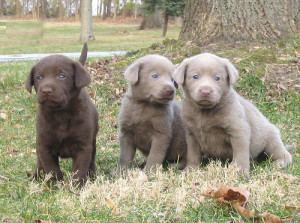 Their life expectancy is generally 10 to 12 years, and it is a healthy breed with relatively few major problems. Notable issues related to health and well-being include:
Their life expectancy is generally 10 to 12 years, and it is a healthy breed with relatively few major problems. Notable issues related to health and well-being include:
Inherited disorders
Labradors are somewhat prone to hip and elbow dysplasia, especially the larger dogs,though not as much as some other breeds.
Hip scores are recommended before breeding and often joint supplements are recommended.
Labradors also suffer from the risk of knee problems. A luxating patella is a common occurrence in the knee where the knee dislocates and goes back into place.
Eye problems are also possible in some Labradors, particularly progressive retinal atrophy, cataracts, corneal dystrophy and retinal dysplasia. Dogs which are intended to be bred should be examined by a veterinary ophthalmologist for an eye score.
Hereditary myopathy, a rare inherited disorder that causes a deficiency in type II muscle fibre. Symptoms include a short stilted gait or "bunny hopping," and in rare cases ventroflexion of the neck accompanied by a kyphotic posture.
There is a small incidence of other conditions, such as autoimmune diseases and deafness in Labradors, either congenitally or later in life.
Labradors often suffer from exercise induced collapse, a syndrome that causes hyperthermia, weakness, collapse, and disorientation after short bouts of exercise.
Out of all dog breeds it is the Labrador Retriever that is most likely to obese. This obesity has been attributed to a specific gene mutation. See the Obesity sub section below.
Obesity
Many dogs, including Labs such as this eight year old, show distinct whitening of the coat as they grow older; especially around the muzzle.
Labradors like to eat, and without proper exercise can become obese. Laziness is a contribution to this. Obesity is a serious condition and can be considered the number one nutritional problem with dogs. A study shows that at least 25% of dogs in the United States are overweight. Therefore, Labradors must be properly exercised and stimulated. A healthy Labrador can do swimming wind sprints for two hours, and should keep a very slight hourglass waist and be fit and light, rather than fat or heavy-set. Obesity can exacerbate conditions such as hip dysplasia and joint problems, and can lead to secondary diseases, including diabetes. Osteoarthritis is very uncommon in older, especially overweight, Labradors. A 14-year study covering 48 dogs by food manufacturer Purina showed that Labradors fed to maintain a lean body shape outlived those fed freely by around two years, emphasising the importance of not over-feeding. Labradors should be walked twice a day for at least half an hour.
It has been shown that out of all dog breeds, it is the Labrador Retriever that is most likely to obese. In a 2016 published study it was shown that out of 310 Labradors, most were missing all or parts of the POMC gene. This gene plays a part in appetite regulation as well as indication of the amount of one's stored fat. The study concluded that the absence of that gene had a significant impact on Labrador weight and appetite. The POMC gene mutation is present in only one other breed - the Flat-coated Retriever.

Yellow Labrador Retriever
|
|||||||||||||||||||||||||||||
| Other names | Labrador | ||||||||||||||||||||||||||||
|---|---|---|---|---|---|---|---|---|---|---|---|---|---|---|---|---|---|---|---|---|---|---|---|---|---|---|---|---|---|
| Common nicknames | Lab | ||||||||||||||||||||||||||||
| Origin | United Kingdom & Canada | ||||||||||||||||||||||||||||
| Foundation stock | St. John's water dog | ||||||||||||||||||||||||||||
|
|||||||||||||||||||||||||||||
|
|||||||||||||||||||||||||||||
| Notes | Provincial mammal of Labrador | ||||||||||||||||||||||||||||
